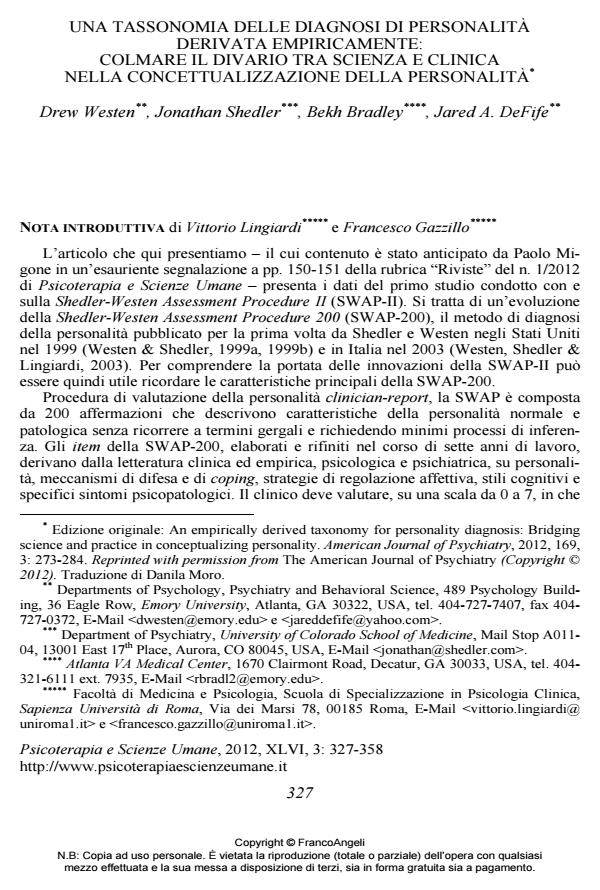An empirically derived taxonomy for personality diagnosis: bridging science and practice in conceptualizing personality
Journal title PSICOTERAPIA E SCIENZE UMANE
Author/s Drew Westen, Jonathan Shedler, Bekh Bradley, Jared A. DeFife
Publishing Year 2012 Issue 2012/3
Language Italian Pages 32 P. 327-358 File size 460 KB
DOI 10.3280/PU2012-003001
DOI is like a bar code for intellectual property: to have more infomation
click here
Below, you can see the article first page
If you want to buy this article in PDF format, you can do it, following the instructions to buy download credits

FrancoAngeli is member of Publishers International Linking Association, Inc (PILA), a not-for-profit association which run the CrossRef service enabling links to and from online scholarly content.
A system for diagnosing personality pathology that is empirically derived, clinically relevant, and practical for day-to-day use is described. A random US sample of psychiatrists and clinical psychologists (N=1,201) described a randomly selected patient with any degree of personality dysfunction using the Shedler-Westen Assessment Procedure-II (SWAP-II). Factor analysis to identify naturally occurring diagnostic groupings yielded 10 clinically coherent personality diagnoses organized into three higher-order clusters: internalizing, externalizing, and borderline- dysregulated. The most highly rated descriptors to construct a diagnostic prototype for each personality syndrome were selected. In a second, independent sample, researchers and clinicians were able to diagnose the personality syndromes with high agreement and minimal comorbidity. These 10 prototypes provide a framework for personality diagnosis that is both empirically based and clinically relevant.
Keywords: Personality disorders, diagnosis and classification, SWAP-II, prototype diagnosis, personality styles and health
- Presentazione del DSM-5 Paolo Migone, in PSICOTERAPIA E SCIENZE UMANE 4/2013 pp.567
DOI: 10.3280/PU2013-004001 - Change After Psychotherapy (CHAP): un metodo di valutazione del cambiamento alla fine della psicoterapia Rolf Sandell, in PSICOTERAPIA E SCIENZE UMANE 4/2015 pp.595
DOI: 10.3280/PU2015-004004
Drew Westen, Jonathan Shedler, Bekh Bradley, Jared A. DeFife, Una tassonomia delle diagnosi di personalità derivata empiricamente: colmare il divario tra scienza e clinica nella concettualizzazione della personalità. Nota introduttiva di Vittorio Lingiardi e Francesco Gazzillo in "PSICOTERAPIA E SCIENZE UMANE" 3/2012, pp 327-358, DOI: 10.3280/PU2012-003001